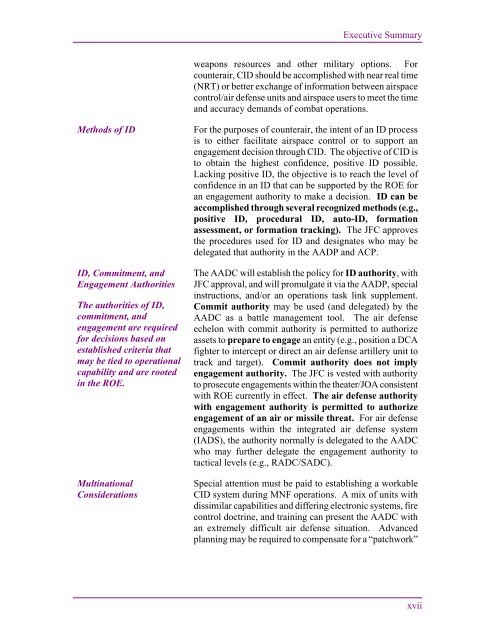JP 3-01 Countering Air and Missile Threats - Defense Innovation ...
JP 3-01 Countering Air and Missile Threats - Defense Innovation ...
JP 3-01 Countering Air and Missile Threats - Defense Innovation ...
You also want an ePaper? Increase the reach of your titles
YUMPU automatically turns print PDFs into web optimized ePapers that Google loves.
Executive Summary<br />
weapons resources <strong>and</strong> other military options. For<br />
counterair, CID should be accomplished with near real time<br />
(NRT) or better exchange of information between airspace<br />
control/air defense units <strong>and</strong> airspace users to meet the time<br />
<strong>and</strong> accuracy dem<strong>and</strong>s of combat operations.<br />
Methods of ID<br />
ID, Commitment, <strong>and</strong><br />
Engagement Authorities<br />
The authorities of ID,<br />
commitment, <strong>and</strong><br />
engagement are required<br />
for decisions based on<br />
established criteria that<br />
may be tied to operational<br />
capability <strong>and</strong> are rooted<br />
in the ROE.<br />
Multinational<br />
Considerations<br />
For the purposes of counterair, the intent of an ID process<br />
is to either facilitate airspace control or to support an<br />
engagement decision through CID. The objective of CID is<br />
to obtain the highest confidence, positive ID possible.<br />
Lacking positive ID, the objective is to reach the level of<br />
confidence in an ID that can be supported by the ROE for<br />
an engagement authority to make a decision. ID can be<br />
accomplished through several recognized methods (e.g.,<br />
positive ID, procedural ID, auto-ID, formation<br />
assessment, or formation tracking). The JFC approves<br />
the procedures used for ID <strong>and</strong> designates who may be<br />
delegated that authority in the AADP <strong>and</strong> ACP.<br />
The AADC will establish the policy for ID authority, with<br />
JFC approval, <strong>and</strong> will promulgate it via the AADP, special<br />
instructions, <strong>and</strong>/or an operations task link supplement.<br />
Commit authority may be used (<strong>and</strong> delegated) by the<br />
AADC as a battle management tool. The air defense<br />
echelon with commit authority is permitted to authorize<br />
assets to prepare to engage an entity (e.g., position a DCA<br />
fighter to intercept or direct an air defense artillery unit to<br />
track <strong>and</strong> target). Commit authority does not imply<br />
engagement authority. The JFC is vested with authority<br />
to prosecute engagements within the theater/JOA consistent<br />
with ROE currently in effect. The air defense authority<br />
with engagement authority is permitted to authorize<br />
engagement of an air or missile threat. For air defense<br />
engagements within the integrated air defense system<br />
(IADS), the authority normally is delegated to the AADC<br />
who may further delegate the engagement authority to<br />
tactical levels (e.g., RADC/SADC).<br />
Special attention must be paid to establishing a workable<br />
CID system during MNF operations. A mix of units with<br />
dissimilar capabilities <strong>and</strong> differing electronic systems, fire<br />
control doctrine, <strong>and</strong> training can present the AADC with<br />
an extremely difficult air defense situation. Advanced<br />
planning may be required to compensate for a “patchwork”<br />
xvii

















